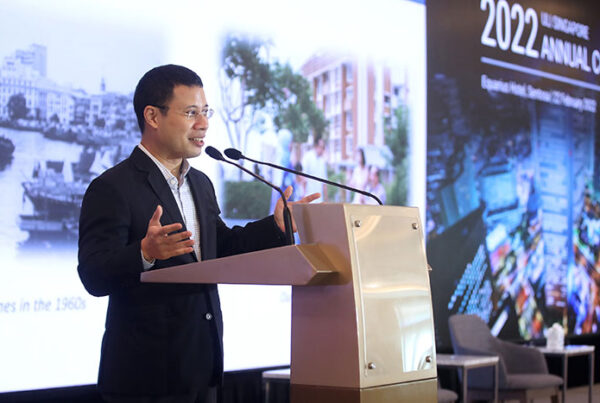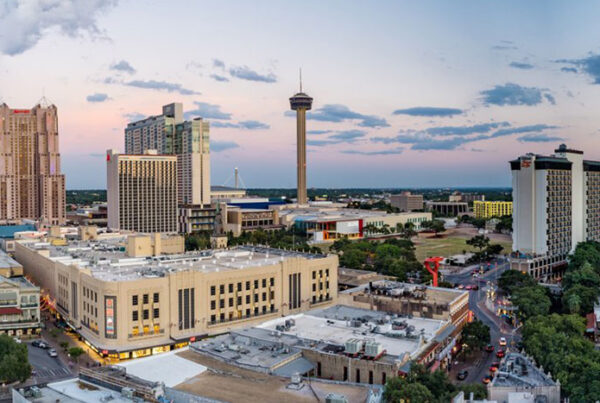
A screenshot from the recent ULI Terwilliger Center webinar, moderated by Michelle Malanca Frey, executive director of ULI San Francisco, and Peter Calthorpe, senior vice president with HDR.
![]() There are certainly some encouraging signs from California with recent legislation hoped to free up land for denser development close to transit and employment centers. But many solutions are needed to help to overcome the deficit in attainable housing in most U.S. cities.
There are certainly some encouraging signs from California with recent legislation hoped to free up land for denser development close to transit and employment centers. But many solutions are needed to help to overcome the deficit in attainable housing in most U.S. cities.
In a recent ULI Terwilliger Center webinar, titled “Grand Boulevards: A Framework for Workforce Housing, Environmental Repair, and Economic Balance,” focused on another possible solution for increasing the availability of housing. Michelle Malanca Frey, executive director of ULI San Francisco, discussed with the influential architect and urban planner Peter Calthorpe, senior vice president at building and infrastructure services firm HDR, who shared his perspective on one such solution.
“Grand boulevards” are commercial corridors anchored by diverse housing options that serve multiple income demographics, largely associated with Parisan boulevards. This type of district doesn’t rely solely on greenfield new housing construction. Instead, according to Calthorpe, grand boulevards take advantage of “grayfields,” underutilized or economically obsolete spaces left over from previous retail occupiers, and ideally leverage Tax Increment Financing (TIF) districts so that increases in value pay for additional development.
The benefits of using this fallow space for housing are many. Calthorpe explained that these developments could “create economic balance across the region, so that the workforce [has] access to jobs, and [is] no longer exiled to long commutes.” In turn, the ripple benefits are diverse and impactful. When compared to sprawling suburbs, these more compact neighborhoods and buildings would use less energy, require less infrastructure to maintain, consume less water, reduce transit costs, and boost tax revenues for local municipalities. Case in point: Calthorpe added that a San Francisco resident’s annual carbon emissions from mobility is around six metric tons, while someone in the suburbs of San Francisco averages around 20 tons per year.
ULI Report: Building Healthy Corridors

Before and after images of a transformed strip center in Sandy Springs, Georgia.
The key to attaining these benefits starts, unsurprisingly, with zoning. Instead of requiring individual zoning approvals for retail to housing conversions along grand boulevards, Calthorpe suggests that these commercial infill redevelopment zoning should be made as of right, so that project sponsors have less red tape to cut through to get their projects off the ground.
At the same time, the solution is not to move toward an “anything goes” style of zoning. Calthorpe’s specific policy recommendation is straightforward and precise: “State legislation that has [infill redevelopment zoning] as of right, with design controls, has inclusionary requirements, and brings back into being tax increment financing.” This sort of legislation would create an outline for grand boulevard housing development and a funding mechanism for it in one fell swoop while dodging racist or exclusionary zoning practices that inequitably benefit white suburban homeowners.
Although grand boulevards are an attractive solution for the interwoven issues surrounding urban housing, getting buy-in for the kind of legislation that Calthorpe thinks we need is challenged by a type of large-scale NIMBYism: “One of the reasons cities are against infill, of course,” Calthorpe explained, “is that it’s a burden financially.” Policies at the state level are one way to address this, by reframing the issue at a higher level than any one individual municipality. And tying grand boulevards directly to the utilization of TIF districts should help quell fears that new, denser districts will put a disproportionate financial strain on the cities that host infill sites.
At the end of the webinar, Malanca Frey posed an audience question: “What needs to come first? Transit, or some of the development being built?” Calthorpe explained that planning for both of these elements, housing and transit, needs to happen simultaneously. We’re currently building corridor multifamily organically without transit, he said, “but at a certain critical mass, the transit needs to come in.” This is where the urban futurists should get excited, because Calthorpe is bullish about the prospect of autonomous vehicles to enhance these corridor-based grand boulevard developments.

Calthorpe highlighted that autonomous electric transit like this one in China could further enhance the value of transit-oriented development along corridors.
Autonomous transit offers benefits over traditional light rail and bus rapid transit systems because self-driving vans need not stop at every station. Both trains and buses follow predefined routes making all scheduled stops along the way, but autonomous vehicles can alter that route based on passenger needs and the presence of riders waiting for a pickup. “Every van is an express van,” Calthorpe said.
While fully autonomous, self-directed transit systems are still a ways off from widespread implementation, self-driving transit solutions are already being utilized in a number of areas. Several pilot studies are already underway, and North America’s longest autonomous transit route, over three and a half miles long, recently opened in Canada.
Grand boulevards by themselves may not be enough to tackle the housing crisis. But together with TIF financing and novel approaches to transit planning, there may be a way forward to develop the housing we need at scale, while protecting the environment and recommitting to our urban centers.
Access other webinars about innovative housing solutions in Knowledge Finder.



